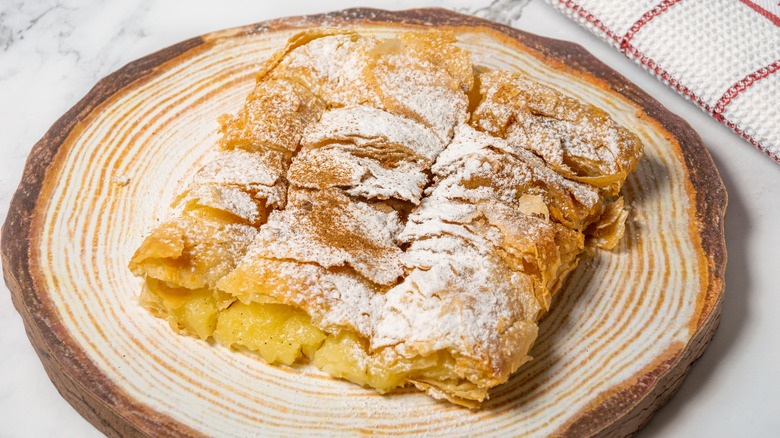What Were The Staple Pie Flavors In Ancient Greece?
Think ancient Greece and you're likely thinking Zeus on Mount Olympus, the birthplace of modern democracy, and maybe the original Olympics. But ... pie? The association between Greece and everyone's favorite sliceable treat is probably not top of mind. But, were you to travel back to ancient Greece, you'd find pie was a culinary staple and yes, yet another pillar of civilization for which we can partially thank the Greeks.
The word pie stems from pye, which, you guessed it, was an ancient Greek and Roman word. Of course, over the millennia, things have evolved, and what we think of as modern pie today doesn't bear much resemblance to the ancient Greek version. These pies were mainly savory flavors in puff pastry, or phyllo dough — another revelation that stems back to the ancient Greeks.
One of the OG flavors, cheese-filled pies called tiropita would have been common, filled with cheese, milk, eggs, and some herbs. As would have been spinach pies along with the introduction of spinach by the Byzantine empire — think of the well-known traditional spanakopita we know and love today, stuffed with greens and salty feta. Not all ancient pies were savory, though many were. You'd have also found mytlotos, filled with garlic, honey, and oil, or ancient equivalents of cheesecake, made with sweet honey and milk. Hungry yet?
Ancient Greek pie was a whole category of food
In ancient Greece, pie was an easy and convenient way to house any leftovers or foods you happened to have around, keeping them good for longer wrapped in phyllo dough, and making an on-the-go food that could have been enjoyed for breakfast, lunch, or dinner. It's easy to imagine why this food became so popular. In pre-refrigeration times, it was a convenient way to use and preserve foods, while creating a meal that could be sold or eaten on the streets. The combination of possible fillings and flavors was virtually endless and varied based on what you had on hand, the region you were in, and what was plentiful and in season.
And, while we think of pie as one basic dish — with varying fillings, the definition was more all-encompassing in ancient times. Think of the difference in the word pudding, as an example. A major difference between American and British pudding is how Brits use the term to describe not just a dish or recipe, but a whole class of types of dishes and even a course. Similarly, pie, according to the ancient Greeks had a broader definition than our modern meaning. Pies could refer to sweet or savory foods, eaten early or late in the day. Even in contemporary times, pies, or pites as they are known, refer to this wider category of food.
How were ancient Greek pies different than the treat we know today?
Pies these days, at least in the U.S., are typically baked in a standard pie crust comprised of flour, water, and butter, but the Greeks did things a little differently. The hallmark of ancient pies in Greece was their phyllo dough crust, as opposed to the modern more biscuit-dough-like crust we make or buy pre-frozen today. Phyllo dough takes meticulous care and time to make and part of what sets ancient Greek pie apart is the time and attention that would have been put into carefully assembling and crushing each thin layer with olive oil.
Ancient Greeks may also have had open-faced pies, with the top and bottom crust style pie coming into fashion later. We know ancients also snacked on savory pies with fig leaves wrapped around them — in fact, the word phyllo translates to leaf. Phyllo can range from thicker to paper-thin incredibly light flaky sheets. And, while the Greeks did the hard work by hand, if all this pie-talk has gotten you inspired to create your own, luckily you can now pick up your ready-to-use frozen phyllo at the grocery stores and honor these ancient flavors without nearly the time and work.


